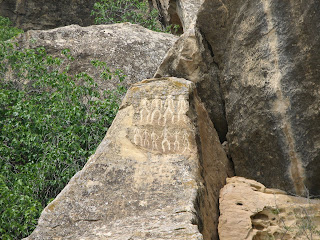

Language is an important part of a student’s education in this school. All students begin learning four languages in the first grade: Azeri, English, Russian, and Arabic. In grade six they also start to learn another modern language, either German or French. As I have learned in my short time here, nearly all language classes begin with a simple “How are you today?” and with writing the date on the board. In addition to this, many teachers ask their students to describe the day’s weather. This light conversation puts students in the right mindset for class, as was the case in a third grade level Russian as a foreign language class that I observed. After a brief discussion about how nice the weather was, the teacher transitioned into teaching the students about the four seasons of the year. By taking a concept, in this case the weather, that the students were already familiar with and building onto it, the teacher was able to build on what the students already knew.
After calling each student to the front of the class to talk about the day’s lesson, the class was allowed to ask that student various other questions in Russian, such as “What is this called?” (pointing to a body part) or “What is your favorite fruit?” This was a brief review of the past lessons and allowed students to strengthen their speaking abilities and listening comprehensions, and also tests the knowledge of the individual answering the question. This encourages students to have the same knowledge level as their peers, and be comfortable in front of the class.
“Today, I started to get acclimated to the classrooms in the Azeri school. I am no longer lost in the school, and I am not so surprised at the difference in the culture of the classroom. Although most of the teachers use some of the same methods in their classrooms, I am starting to see differences in their teaching styles… The teachers here use almost 100% positive reinforcement. If a student is not staying in their seat or speaking out of turn, they will be ignored. The students who get the most attention from the teacher are the students who answer frequently. The students would rather get a question wrong and receive feedback than be invisible,” (Manci, C. May 19, 2009).
“The first thing I noticed going to the next class was that the relationship between the teacher and the students was very friendly and open. It was a six grade English class, and Ms. K. was the teacher. The students gathered around her desk before class began and they all talked and laughed until the bell rang. While most students were talking to Ms.K., some were getting started with the lesson before the bell by writing the date and the day on the board.” (Knapp, K. May 19, 2009)
The next class I observed was an eighth grade level class which was taught by Catherine. Part of her lesson involved the students reading aloud about Johnny Appleseed. While the individual students read aloud, I noticed a few issues that they had with pronunciation, such as saying past tense words with an “-ed” ending as a separate syllable, or pronouncing “wild” as “willed.” These are common pronunciation mistakes that even some young native English students might make, and could probably be remedied by hearing more native English speakers, so that the students could hear the correct way to say the words.
Despite these mistakes, the students still seem very comfortable speaking in front of their classes. The teachers tell us that the students are nervous because they have guests, but I find this hard to believe, because overall the students still perform outstandingly.











